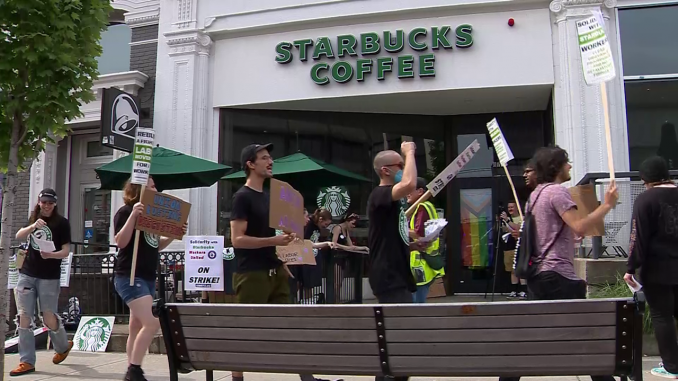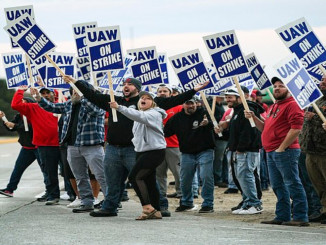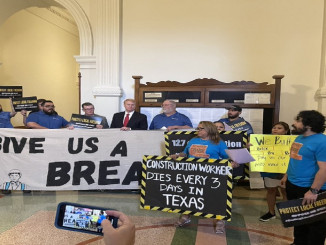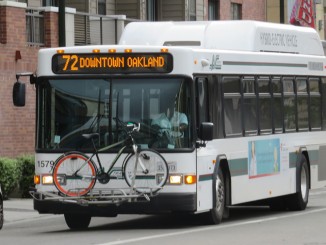
This is a repost of a recent article by Adam Shils for the International Socialism Project, originally posted on August 17, 2022. We post reprints like this to call attention to important ideas that might influence working class and other organizing, whether we agree with those ideas wholeheartedly or not, and to stimulate constructive discussion of topics under debate within the left.
When one looks at the American labor movement today, one immediately sees an important contradiction. There are very few strikes, yet a considerable number of young people, most prominently at Starbucks, are organizing into unions. The purpose of this article is to look at these two aspects of labor’s current situation.
We should begin by looking at the strikes taking place today. Today, there are only two open-ended strikes involving workplaces with more than about a thousand workers. (The number of miners on strike at Warrior Met has now fallen to under a thousand.) The largest is at CNH Industrial, a maker of agricultural equipment. These workers have been on strike since May. One of their key demands is that union-organized plants should be brought up to the pay level of the non-union plants. Things are at a standstill at the bargaining table, but a session has now been scheduled for August 17.
The other big strike is the coal miners at Warrior Met in Alabama. These workers have been on strike for sixteen months now with no sign of any impending settlement. In a bizarre development, Region 10 of the NLRB has fined the union $13.3million for various actions during the strike. What makes this fine so unusual is that one of the charges is causing the company loss of profits. If employers were able to sue a union to recover profits lost due to strikes, the whole possibility of striking, and indeed collective bargaining as whole, would be prohibited. It’s obviously hard to read the situation from afar, but it’s certainly possible that this is really a bargaining chip by management, to be dropped at a later date. It’s also possible that the fine will be reversed on appeal. If the fine is allowed to stand, it would be a very ominous development for the union movement.
The July BLS strike statistics show CNH as the only ongoing strike of more than a thousand workers, leading the amount of worktime lost due to strikes at less than 0.005% of total worktime.
Contract expirations in 2022
Last December, Dan DiMaggio wrote an important article in Labor Notes. Dan collated the main contracts due to expire in 2022. A number of commentators believed that many of these contracts might well end in shows of working class militancy. It’s useful to go down the list and see how these contracts ended up. (I’ve added a couple of my own to Dan’s list.)
1). Kroger/Albertsons groceries: settled in April-no strike.
2). Stop and Shop groceries: settled in May- no strike.
3). West Coast longshore: contract extended while negotiations continue.
4). Teamster car haul drivers: settled in July-no strike.
5). Marathon Oil: settled in February-no strike.
6). Goodyear rubber: settled in July-no strike.
7). Michigan Medical: contract expired and negotiations continue.
8). St. Louis Boeing: settled in August-no strike.
9). Frontier telecom: contract expired last fall, now working without a contract.
10). Railroads. Here the situation is quite complicated. Eleven different unions are negotiating with seven freight carriers. Two issues stand out in addition to normal points such as wages and health care. The first is the carriers’ wish to increasingly move to one person crews. The second is the draconian Hi-Viz attendance policy that substantially limits workers’ ability to take time off. Rail and airline unions are covered under the Railroad Labor Act, not the NLRA as most unions are. Under the RLA’s arcane provisions, if no agreement is reached the President can institute a Presidential Emergency Board. Biden did this on July 17. The Board has 30 days to make a proposed settlement. There then follows another 30 days of a “cooling- off” period. If there’s still no agreement, a strike is then possible. However, at this point Congress is allowed to order a return to work, using the commerce clause of the Constitution. This normally happens within hours of a possible strike being called!
[Note: most school teacher contracts do not expire until school starts in the fall, so it’s too early to make any assessment.]
The overall point is clear: there is no upturn in strike struggles today and those workers on strike face a hard road ahead.
Venti, Grande, Mocha Double, union busters you’re in trouble!
However, as this superb chant makes clear the mood and situation is quite different among young people in the food and service industries. Here, Starbucks is obviously at center stage. 209 stores have now been unionized. This is a real achievement. There have been at least twelve strikes by Starbucks workers. The movement clearly has some spring in its step. In fact, union recognition election filings with the NLRB are up 58% from the same time period last year.
A number of comments can be made about the Starbucks organizing drive. One, the smallness of the stores has led to strong social bonds among the workers. This close knit friendship has helped create the solidarity needed for union organization.
Two, many workers took Starbuck’s progressive image seriously. They supported the goals Starbucks claimed to espouse: Black Lives Matter, women’s rights, LGBT rights, and the environment. They wanted to work for an employer who supported these concepts. They were then dismayed when Starbucks responded with hostility to union organization. This impelled them to question the whole ethos of Starbucks.
Three, working during Covid was intolerable. Management did not take the workers’ health concerns seriously. Furthermore, the general social decay in this country has led to increased customer hostility and belligerence. This has led some workers to fear for their physical safety. Again, management’s response was weak.
Four, this unionization wave is by no means limited to Starbucks. Unions have had victories at an Apple store in Maryland, at Google Fiber, at REI outdoor supplies, at Trader Joe’s groceries, at Kickstarter, and at Activision Blizzard. Other coffee stores such as Colectivo and Intelligentsia have also seen union organizing successes.
Five, the new wave of unionization takes place in a layer of workers that’s generally not been involved in the labor movement. The Starbucks unionists are mainly young, college educated, supporters of liberal and progressive causes such as Black Lives Matter and the Bernie Sanders campaign. Drawing this new demographic into the labor movement is an important achievement.
Finally, as always, we should keep things in perspective. While 209 stores have unionized , 45 lost their union recognition elections. There are about 9,000 Starbucks in this country, so there’s a long way to go. The size of the new unions at Google Fiber, Kickstarter and Activision Blizzard are still very modest. The main point to be made is that we are in for the long haul, but a good beginning has been made. Let’s build on it.




